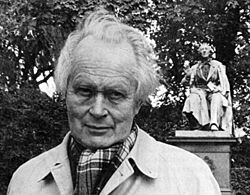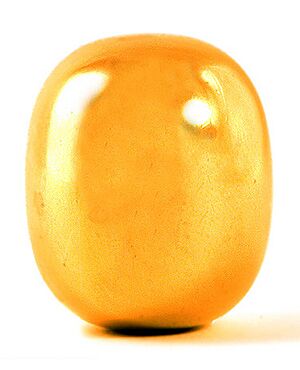Piet Hein (scientist) facts for kids
Quick facts for kids
Piet Hein
|
|
|---|---|

Piet Hein (Kumbel) in front of the H.C. Andersen statue in Kongens Have, Copenhagen, 1983
|
|
| Born | 16 December 1905 |
| Died | 17 April 1996 (aged 90) |
| Known for | Puzzles, poems |
Piet Hein (born December 16, 1905 – died April 17, 1996) was a brilliant person from Denmark. He was a polymath, which means he was good at many different things! He was a mathematician, an inventor, a designer, a writer, and a poet.
Piet Hein often wrote under the special name Kumbel. This old Norse word means "tombstone". He became famous for his short poems called gruks or grooks. These poems first appeared in a newspaper called Politiken after Germany took over Denmark in 1940. Piet Hein also invented the fun Soma cube puzzle and the board game Hex.
Contents
About Piet Hein's Life
Piet Hein was born in Copenhagen, Denmark. He was a direct descendant of a famous Dutch naval hero from the 1600s, also named Piet Hein.
He studied at important places like the Institute for Theoretical Physics at the University of Copenhagen. This institute later became the Niels Bohr Institute, named after a famous scientist. He also studied at the Technical University of Denmark. Later in 1972, Yale University gave him a special honorary degree. Piet Hein passed away in his home in Funen, Denmark, in 1996.
Piet Hein and the Resistance
During World War II, Germany took control of Denmark. This was a very difficult time for Danish people. Piet Hein faced a big choice: do nothing, leave Denmark for a neutral country like Sweden, or join the Danish resistance movement.
He decided to join the Resistance. He explained that he couldn't just stay home and be scared. He also felt he belonged in Denmark, not Sweden. So, he chose to fight back in his own way.
Piet Hein used his writing skills as his first weapon. He wrote his first "grook" (Danish: gruk) and got it published. The people in charge of checking for hidden messages didn't understand its true meaning.
CONSOLATION GROOK
Losing one glove
is certainly painful,
but nothing
compared to the pain
of losing one,
throwing away the other,
and finding
the first one again.
But the Danish people understood it perfectly! Soon, this poem was written as graffiti all over the country. The poem's secret message was this: even if you lose your freedom (like "losing one glove"), don't give up your pride and love for your country by working with the invaders ("throwing away the other"). Because if you do, that feeling of having betrayed your country will hurt even more when freedom finally returns.
Fun with Math and Design
Piet Hein loved to combine math with design. In 1959, city planners in Stockholm, Sweden, needed a new design for a roundabout in their main square, Sergels Torg. Piet Hein's idea won! His design was based on a special shape called a superellipse.
He then used the superellipse shape for many other things, like furniture and household items. He also invented a special calendar called the Astro Calendar. He even made kitchen tools and other products based on the superellipse and its 3D version, the superegg.
Piet Hein also invented many puzzles and games. These include the Soma cube, Hex, Tangloids, Tower, Polytaire, TacTix, Nimbi, Qrazy Qube, and Pyramystery.
He was good friends with Martin Gardner, a famous writer about math games. Piet Hein's work often appeared in Gardner's "Mathematical Games" column in Scientific American magazine.
See also
- Flipism
Piet Hein's Family
Piet Hein was married four times and had five sons.
- Sons: Juan Alvaro Hein, Andrés Humberto Hein, Lars Hein, Jotun Hein, and Hugo Piet Hein.


